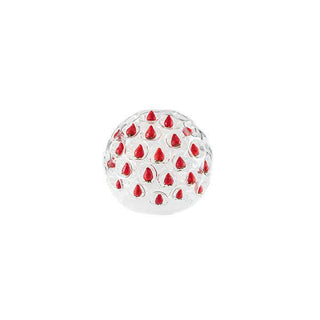Undersized Armchair has compact dimensions with internal structure in solid wood and CFC-free soft polyurethane foam, shaped from the block, featuring different densities of the material. Cover in fabric or leather.
Designed by Maison Margiela for Baleri Italia.
On our page, we present the cover in the leather version(cat.B). The Sofa completes the Undersized Collection.
Dimensions: l. 60, h. 74, p. 68
Contact us for delivery times and quotations
MAISON MARGIELA DESIGN
Martin Margiela is a fashion designer par excellence. Whether this comment could be read as a cliché in the case of Martin Margiela is totally justified. Unlike traditional fashion designers, his creations are perceived as works of “metamoda” and he is ranked among the most influential and iconoclastic designers of the last 40 years. Born in 1959 in Limbourg, Belgium, and trained by the Royal Academy of Antwerp, he is one of the very first talents of the city. His working career began as an assistant alongside the great Jean Paul Gaultier and in 1988 he founded his Maison Martin Margiela in Paris where he made his debut with the first Spring Summer 1989 collection. In search of a definition with which to label Margiela’s fashion full of provocations, the mania for the creative process, and sartorial mastery to make his garments, the press has classified all this new approach, defining it as the father of the deconstruction technique. Deconstructing clothes means cutting and reassembling parts of old clothes, showing linings and internal parts, detaching and reassembling the sleeves in a new way. His approach was a hymn that brought voice to a new democratic fashion that winks at the sartorial freedom of the 70s and favors the use of recycled materials rather than following an idea of fashion as luxury and ostentation. This concept takes up and expands the practice of punk and street style of cutting and tearing t-shirts and jeans. The dominant colors in his early collections are powerful colors such as black, white, and red.
Starting from the 90s, a new trend began to appear, born in contrast to the appearance and ostentation of the 80s and Martin Margiela as a witness of the time decided to promote the cult of impersonality, eliminating all its traces. He refused interviews, even to faxes and telephone calls he adopted the formula of plural maiestatis, always answering in the name of the Maison. There is little information about him and the strength of the Maison itself was based on the absence of Martin. Considered as a real destroyer of the fashion system, the Belgian designer took the life out of clothes by removing his name from the label and becoming a pure abstraction, the legendary tag (fixed only by 4 stitches) becomes white to let his creations speak. From 1997 to 2003, in addition to his Maison, he dedicated himself to the Hermès women’s collections in which he experimented with his minimalist cuts and deconstruction also in the world of leather goods. In 2002 Renzo Rosso, owner, and president of Diesel’s Only The Brave group acquired the brand and in 2014 he definitively left the scene, leaving the place of the Maison Margiela to the current creative director John Galliano.
Undersized Armchair has compact dimensions with internal structure in solid wood and CFC-free soft polyurethane foam, shaped from the block, featuring different densities of the material. Cover in fabric or leather.
Designed by Maison Margiela for Baleri Italia.
On our page, we present the cover in the leather version(cat.B). The Sofa completes the Undersized Collection.
Dimensions: l. 60, h. 74, p. 68
Contact us for delivery times and quotations
MAISON MARGIELA DESIGN
Martin Margiela is a fashion designer par excellence. Whether this comment could be read as a cliché in the case of Martin Margiela is totally justified. Unlike traditional fashion designers, his creations are perceived as works of “metamoda” and he is ranked among the most influential and iconoclastic designers of the last 40 years. Born in 1959 in Limbourg, Belgium, and trained by the Royal Academy of Antwerp, he is one of the very first talents of the city. His working career began as an assistant alongside the great Jean Paul Gaultier and in 1988 he founded his Maison Martin Margiela in Paris where he made his debut with the first Spring Summer 1989 collection. In search of a definition with which to label Margiela’s fashion full of provocations, the mania for the creative process, and sartorial mastery to make his garments, the press has classified all this new approach, defining it as the father of the deconstruction technique. Deconstructing clothes means cutting and reassembling parts of old clothes, showing linings and internal parts, detaching and reassembling the sleeves in a new way. His approach was a hymn that brought voice to a new democratic fashion that winks at the sartorial freedom of the 70s and favors the use of recycled materials rather than following an idea of fashion as luxury and ostentation. This concept takes up and expands the practice of punk and street style of cutting and tearing t-shirts and jeans. The dominant colors in his early collections are powerful colors such as black, white, and red.
Starting from the 90s, a new trend began to appear, born in contrast to the appearance and ostentation of the 80s and Martin Margiela as a witness of the time decided to promote the cult of impersonality, eliminating all its traces. He refused interviews, even to faxes and telephone calls he adopted the formula of plural maiestatis, always answering in the name of the Maison. There is little information about him and the strength of the Maison itself was based on the absence of Martin. Considered as a real destroyer of the fashion system, the Belgian designer took the life out of clothes by removing his name from the label and becoming a pure abstraction, the legendary tag (fixed only by 4 stitches) becomes white to let his creations speak. From 1997 to 2003, in addition to his Maison, he dedicated himself to the Hermès women’s collections in which he experimented with his minimalist cuts and deconstruction also in the world of leather goods. In 2002 Renzo Rosso, owner, and president of Diesel’s Only The Brave group acquired the brand and in 2014 he definitively left the scene, leaving the place of the Maison Margiela to the current creative director John Galliano.









